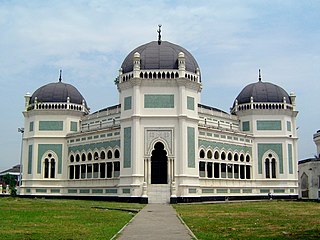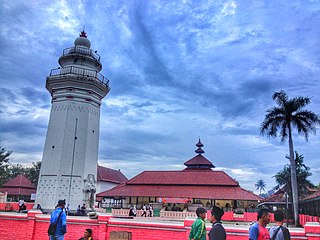
North Maluku is a province of Indonesia. It covers the northern part of the Maluku Islands, bordering the Pacific Ocean to the north, the Halmahera Sea to the east, the Molucca Sea to the west, and the Seram Sea to the south. It shares maritime borders with North Sulawesi, Southeast Sulawesi and Central Sulawesi to the west, Maluku to the south, Southwest Papua to the east, and Palau and the Philippines to the north. The provincial capital is Sofifi, mostly part of the city of Tidore Islands on the largest island of Halmahera, while the largest city is the island city of Ternate. The population of North Maluku was 1,038,087 in the 2010 census, making it one of the least-populous provinces in Indonesia, but by the 2020 Census the population had risen to 1,282,937, and the official estimate as at mid 2023 was 1,328,594.

Satu Suro is the first day of the Javanese calendar year in the month of Suro, corresponding with the first Islamic month of Muharram. It is mainly celebrated in Java, Indonesia, and by Javanese people living elsewhere.

Candi Bahal, also known as Biaro Bahal or Candi Portibi is Vajrayana Buddhist candi complex in Bahal village, Padang Bolak, Portibi, Padang Lawas Regency, North Sumatra, Indonesia. It is located about three hours journey with car from Padangsidempuan or 400 km from Medan. The complex includes three candis: Candi Bahal I, Candi Bahal II, and Candi Bahal III. The temple site is linked to Pannai Kingdom circa 11th to 13th century CE.

Gorontalo people, also known as Gorontalese, are a native ethnic group and the most populous ethnicity in the northern part of Sulawesi. The Gorontalo people have traditionally been concentrated in the provinces of Gorontalo, North Sulawesi, and the northern part of Central Sulawesi.

Grand Mosque of Medan or Masjid Raya Al-Mashun is a mosque located in Medan, Indonesia. The mosque was built in the year 1906 and completed in 1909. In beginning of its establishment, the mosque was a part of the Maimun palace complex. Its architectural style combines Middle Eastern, Indian, and Spanish elements. The mosque has an octagonal shape and has wings to the south, east, north, and west.

Kauman Great Mosque, approximate English translation of Javanese Mesjid Gedhe Kauman, is a Great Mosque of the Yogyakarta Sultanate in Java, Indonesia. It is located to the west of the North Alun-alun of Yogyakarta Kraton.

The Great Mosque of Surakarta is an 18th-century Javanese mosque in Surakarta, Central Java, Indonesia. It is the royal mosque of the Surakarta Sunanate.

The Great Mosque of Palembang, also known as Sultan Mahmud Badaruddin I Great Mosque after the former Sultan of Palembang, is the main mosque of Palembang, the capital of South Sumatra. The mosque is the largest in South Sumatra, and the third largest mosque in Sumatra after the Grand Mosque of West Sumatra and Great Mosque of Pekanbaru.

Kasunyatan Mosque is a small mosque in the village of Kasunyatan, Banten, Indonesia. Established between 1570 and 1596, it is one of the oldest mosques in Indonesia. The mosque is located in close proximity to the ruins of Old Banten, and functioned as a 16th-century centre of Islamic study. The mosque received a heritage status during the Dutch colonial period in 1932.

The Grand Mosque of Bandung, previously known as the Great Mosque of Bandung, is a mosque in Bandung, the a provincial capital of West Java, Indonesia. The mosque received the status of provincial mosque in West Java Province in 2004. It is located on the east side of the alun-alun of Bandung.

Great Mosque of Banten is a historic mosque in Old Banten, 10 km north of Serang, Indonesia. The 16th-century mosque was one of the few surviving remnants of what used to be the port city of Banten, the most prosperous trading center in the Indonesian archipelago after the fall of Demak Sultanate in mid-16th century.

Azizi Mosque is a mosque located in Tanjung Pura, Langkat Regency, North Sumatra, Indonesia. It was the royal mosque of the Sultanate of Langkat.

A wantilan is a Balinese pavilion (bale) used for activities involving large crowds. A wantilan is the largest type of bale in Balinese architecture. A wantilan is basically a large wall-less hall placed under a large multi-tiered roof. A wantilan as a public building is usually located at a village's main square or main junction and functions as an open hall to hold large community activities such as meeting halls or a public musical gamelan performance. A wantilan is also a religious building, an integral part of Balinese temples used to hold the Balinese cockfighting ceremony.

Kyai Gede Mosque, officially known as the Jami Mosque of Kotawaringin, is a mosque located in West Kotawaringin Regency, Central Kalimantan, Indonesia.

Mosque architecture in Indonesia refers to the architectural traditions of mosques built in the archipelago of Indonesia. Initial forms of the mosque, for example, were predominantly built in the vernacular Indonesian architectural style mixed with Hindu, Buddhist or Chinese architectural elements, and notably didn't equip orthodox form of Islamic architectural elements such as dome and minaret. Vernacular architectural style varies depending on the island and region.

Al-Wustho Mangkunegaran Mosque is a historic mosque located in the Central Javanese city of Surakarta, to the west of the Mangkunegaran Palace. The mosque is one of the three oldest mosques of Surakarta. Al-Wustho Mangkunegaran Mosque was inaugurated as a state mosque of the Mangkunegaran Palace.

A balairung is a village hall of the Minangkabau people of West Sumatra, Indonesia. It has a similar architectural form to the rumah gadang, the domestic architecture of the Minangkabau people. Whereas a rumah gadang is a proper building, the balairung is a pavilion-like structure used solely for holding a consensus decision-making process in the Minang society.

The Kingdom of Banggai was a petty kingdom in present-day Central Sulawesi, Indonesia. It was based around the Banggai Islands and the eastern coast of Sulawesi, centered at the island of Banggai. For a significant part of its history, the kingdom was under the overlordship of the Sultanate of Ternate. Its' rulers held the title of Raja.

Cungkup is an Indonesian square building with a roof made to shade or protect something, usually a grave, inscription, or nameplate. They are also used to shade other important objects. The cungkup has also been thought to have inspired the tiered-roof style of Javanese mosques, this theory is supported by the fact that cungkup aren't tiered, with the Giri Cungkup in East Java as the only known exception.





















